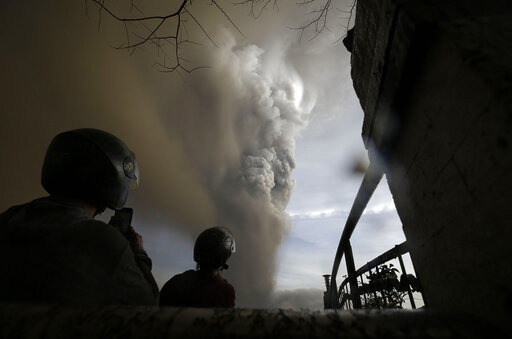A mass evacuation is underway in the Philippines, where an erupting volcano 40 miles (65 kilometers) south of the capital has triggered some 75 earthquakes and spewed “ballistic fragments,” forcing the nation’s financial markets to suspend trading and Manila airport to close.
A “hazardous explosive eruption is possible within hours to days,” the Philippine Institute of Volcanology and Seismology said Monday morning. Thousands of people have been evacuated since late Sunday, with plans to move as many as 200,000 people. Officials ordered schools and government offices shut, and advised private businesses to do the same.
Weak lava fountaining, accompanied by thunder and flashes of lightning, indicated intense activity at the main crater of the Taal Volcano, the volcanology agency said. Dozens of towns and urban areas all the way to Metro Manila, including the main business district of Makati City, are enduring ash fall and volcanic particles up to 2.5 inches (64 millimeters) in diameter.
“It’s been endless evacuation since last night,” said Lita Laverinto, an operations officer with the Office of Civil Defense in Calabarzon. “We need masks; our volunteers and respondents who are directing rescues and evacuation really need them.”
Manila’s international airport, the country’s main gateway, remains closed until the airspace and runways are clear of volcanic debris, authorities said in a statement.
About 200 flights were canceled, affecting about 60,000 passengers, according to statement from Cebu Air Inc. and Philippine Airlines Inc. The airport may resume partial operations on Monday, its General Manager Ed Monreal told to local radio DZMM.
Bank of the Philippine Islands, the nation’s oldest lender, suspended operations in “badly affected areas,” mostly in Batangas and Cavite and allowed some staff in less-affected areas to work remotely, according to Owen Cammayo, vice president of corporate communications. The bank will decide later today if it will close early, he said.
Chain Reaction?
More than 20,000 residents from 14 towns have been moved to some 73 evacuation centers in the provinces of Batangas and Cavite, as of 6 a.m. Monday. Hundreds of thousands more may need to be evacuated if eruptions in the main crater cause surrounding craters to explode.
Taal is considered the second-most active volcano in the Philippines. Located in the middle of a lake less than 10 kilometers inland of Balayan Bay on the island of Luzon, Taal Volcano has some 30 active craters, according to Batangas province Vice Governor Mark Leviste.
“Right now, we are witnessing a vertical eruption, and thanks to God we are just experiencing ash fall,” Leviste told DZBB radio Sunday. “But if this turns into an horizontal explosion, this could affect the mainland.”
A change of wind direction means ash is blowing over municipalities not included in earlier emergency plans, swelling the number of communities affected.
Poor Visibility
“Our problem is access to affected areas,” said Jovener Dupilas, an information officer with the Office of Civil Defense. “The ash fall is so thick and heavy that visibility is poor and some trees even fell.”
In metropolitan Manila, traffic is lighter than usual, indicating that while many private companies haven’t suspended work, many employees have stayed home anyway.
The Philippines is one of the most disaster-prone countries in the world. Battered by about 20 typhoons annually, the country also sits on the “Pacific Ring of Fire,” subjecting it to earthquakes and volcanic eruptions.
Between 2000 and 2016, natural disasters in the Philippines caused more than 23,000 deaths and affected 125 million people, according to the Asian Development Bank. The socioeconomic damage was about $20 billion with average annual damage estimated at $1.2 billion, it said.–With assistance from Siegfrid Alegado, Andreo Calonzo, Ditas Lopez, Claire Jiao and Clarissa Batino.
About the photo: People watch as Taal Volcano erupts Sunday in Tagaytay, Cavite province, outside Manila, Philippines. A tiny volcano near the Philippine capital that draws many tourists for its picturesque setting in a lake belched steam, ash and rocks in a huge plume Sunday, prompting thousands of residents to flee and officials to temporarily suspend flights. (AP Photo/Aaron Favila)
Was this article valuable?
Here are more articles you may enjoy.


 Cyber Breach Affected 750,000 Canadian Investors, Regulator Says
Cyber Breach Affected 750,000 Canadian Investors, Regulator Says  Musk’s xAI Faces California AG Probe Over Grok Sexual Images
Musk’s xAI Faces California AG Probe Over Grok Sexual Images  Billionaire NFL Owner Suing Over Billboards Near His SoFi Stadium
Billionaire NFL Owner Suing Over Billboards Near His SoFi Stadium  Storm Goretti Batters Europe With Violent Winds, Power Cuts
Storm Goretti Batters Europe With Violent Winds, Power Cuts 